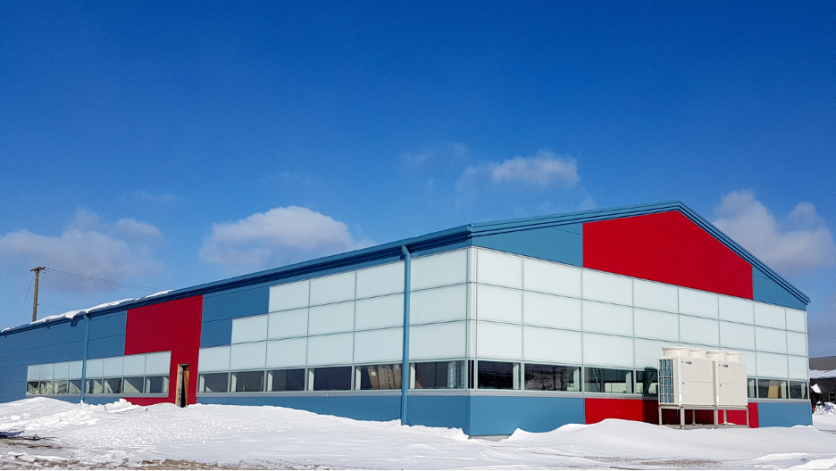
A great building requires a great building envelope- and that envelope has a lot of work to do. First, it must keep out the elements, insulate against heat and cold, and manage unwanted air and water penetration. But it must also do more than just isolate. A great envelope connects building occupants to the outside world via natural daylight and views. And in addition to all of that, a great envelope must be practical to build, and affordable in the context of the entire building project.
Insulated metal panels are a modern building component that are seeing wider adoption in today's marketplace across a host of varied applications. Insulated metal panels, or IMP's, have a foam core and steel skins. They are simultaneously interior and exterior wall, as well as roof cladding. IMPs have multiple advantages including excellent thermal and water resistance. They are strong, quiet, air-tight and they install very quickly and cost effectively. You will see IMPs being used on more and more structures from simple pre-engineered metal buildings to higher end architectural applications.
In North America, IMPs are most commonly seen in buildings such as factories, warehouses, distribution centers, and big box stores. Most are installed in a vertical configuration, typically with continuous spans from slab to roof. Their advantages are many. Installation is extremely fast and reliable. There are no horizontal seams, and vertical seams are highly leak resistant tongue and groove. The panels have very high insulation values, from R18 up to R40, and there is limited thermal bridging. They are prefinished inside and out, with warranties that span many decades. In other words, practical, cost effective, and reliable.
However, vertical IMP installations have a big limitation in that they don't naturally integrate with glass. Glass can certainly be installed, but the typical punched openings are awkward, costly relative to the panelling and the subframing, and far from aesthetically pleasing. Worse still, the resultant daylight patterns are troublesome due to glare, and as a result blinds must be installed which destroy the view and block the daylight. This difficulty in connecting to the outdoors results in classic 'dark boxes'- structures that, while practical and cost effective, are most definitely not nice for people to spend significant amounts of time inside, and in the end, this greatly compromises their overall value.
Horizontal IMP plus SoleraWall® - A Tremendous Opportunity for High Value Human-Occupied Buildings
Fortunately, there is another approach that unlocks IMPs' potential for creating high value human occupied buildings. Horizontal IMP installation has been around as long as IMP itself, but presently comprises a minority of installations, especially in North America. On its own, horizontal IMP installation offers a much more sophisticated and modern aesthetic than vertical installation. But the development of a new glazing system called SoleraWall® has impacted the IMP landscape, tipping the scales to highly favour horizontal installation vs vertical - and this, to most people in the built environment, is new news. SoleraWall® makes it incredibly simple to integrate views and daylight into horizontal IMP envelopes, resulting in IMP buildings that are much more friendly to human occupants.
So, what are the many advantages of this new horizontally oriented envelope? Let's start on the outside. While it's true that horizontal applications require slightly more infrastructure, they create a much more aesthetically pleasing building from the outside with a look that is certainly more "high end", feeling. The look of a building is not superficial, but rather, an important consideration for any CFO, savvy building owner or planner interested in one day garnering significantly greater resale value in their total real estate investment: the structure + property combination. Better looking buildings are just simply expected to command a higher value in the marketplace, and this is "settled business" that just makes plain good sense to buyers. Horizontal applications simply work better when buildings are being used for more elevated purposes.
On top of this, the combined horizontal building envelope will retain its good looks for a very long time. Insulated metal panels have extremely durable finishes, often warrantied for 30 years or more. Solera® is made from glass, which has a nearly timeless finish quality.
But an even bigger deal is that SoleraWall® enables easy inclusion of natural light and views. Metal-based structures with human occupation (think factories, grocery, big box, sports facilities, etc.) require views and daylight to ensure that employees inside remain healthy and productive, and that customers/clients feel comfortable as well. You don't need me to tell you that entire industries derive their value from an engaged, satisfied, more productive, healthy and well employee - and the built environment where they spend their day is critical to nurturing and sustaining those humans.
It has not been a simple task to create proper daylight and views effectively in any structure. Used on its own, transparent 'vision glass' creates glare patterns which can create serious discomfort for occupants. And new building codes demand high thermal performance in the envelope, which can be compromised by use of large amounts of poorly insulating vision glass. This challenge exists in all buildings.
The horizontal IMP + SoleraWall® combined building envelope system is modular in nature and allows mixing and matching of opaque elements and vision elements, but also enables the use of highly insulating light diffusing, or translucent elements that convert direct sunlight into soft gentle natural light. This evenly illuminates interiors and mitigates glare by backfilling shadows to reduce contrast, providing a quality aesthetic and superb, unmatched performance. Thus, it is now easier to create highly functional and beautiful daylighted spaces that were previously only available in the highest end of architecture. And this can now be done while delivering a host of upsides, including up to 15% productivity improvement, and 20% increase in retail sales.
A final set of benefits derive from the fact that SoleraWall® attaches directly to the primary structure in the same manner as IMP. This makes it incredibly modular and easy to design with. It also means it installs quickly and inexpensively and where permissible, can be installed by the same crew that installs the IMP. There is no awkward, expensive, and thermally leaky framing required. This results in significant cost savings over other envelopes of equivalent value.
It's my view that SoleraWall® + IMP are the great building envelope that is needed to create Better Buildings For Humans, something we care a lot about at my firm.
About Doug Milburn

As a long-time entrepreneur and innovator, Dr. Doug Milburn, founder of Advanced Glazings, thrives on solving problems. For more than 35 years, he's brought passion and vision to manufacturing, engineering, software development and process engineering. Throughout his leadership, Dr. Milburn has aimed to create great workplaces by shaping a company's success through corporate values and ethical guidelines.
About Adanced Glazings Ltd.
Great buildings need a connection to the outdoors, one that is only achieved through the use of glass. At Advanced Glazings Ltd, we understand that making that connection is challenging. Our Solera® line of highly insulating light diffusing glass and decades of combined experience in daylight design make it easy for you to create buildings that are stunning and will 'wow' everyone who enters. We also host and produce a podcast called Better Buildings for Humans, the premier destination for the best content anywhere about the ways the built environment impacts health, wellness, productivity, and more.




